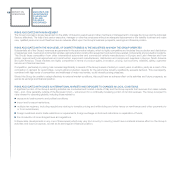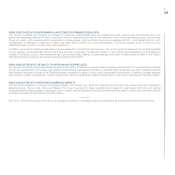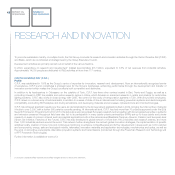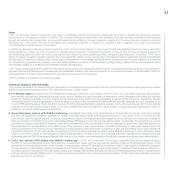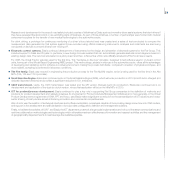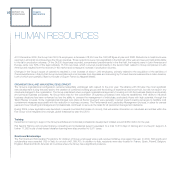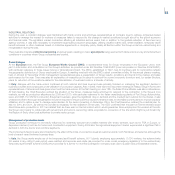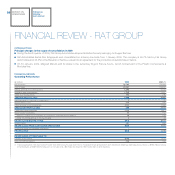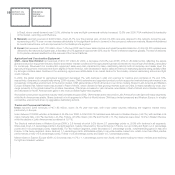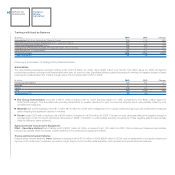Chrysler 2009 Annual Report Download - page 55
Download and view the complete annual report
Please find page 55 of the 2009 Chrysler annual report below. You can navigate through the pages in the report by either clicking on the pages listed below, or by using the keyword search tool below to find specific information within the annual report.
REPORT ON
OPERATIONS
HUMAN
RESOURCES
54
For FGA, government initiatives in the form of eco-incentives to consumers adopted in many European countries during 2009 to stimulate demand had a
positive flow-through effect including for some of the Group’s Italian plants, resulting in a reduction in the use of the temporary layoff benefit scheme and, in
some cases, making it necessary to resort to overtime, or to transfer or second employees from other sites and companies where production stoppages
were in effect, in order to respond to the increase in orders for certain models.
Under these extremely difficult circumstances, the Group succeeded, nonetheless, in converting 530 fixed-term contracts and 830 apprenticeship contracts
into unlimited term employment contracts.
Outside Italy, production stoppages were also necessary to respond to the significant deterioration in volumes. Almost all Sectors utilised Chômage
Partiel in France, Expediente de Regulación de Empleo in Spain and Kurzarbeit in Germany. In the United States, CNH instituted temporary layoffs at its
plants in Wichita, Burlington and Calhoun, all belonging to the Construction Equipment business. Suspension of production activities, which took various
forms, also involved the plants of certain Sectors in other countries, such as Poland, Belgium and the UK.
In Brazil, workforce reductions were made in the first quarter, primarily for blue collars, in response to the drop in production volumes attributable to the
economic crisis, which began to ease in the second quarter. The reversal in the trend resulted in an increase in plant output and, consequently, a return to
hiring and use of overtime.
In Poland, a significant increase in production volumes for Fiat Group Automobiles, driven by the introduction of eco-incentives and satisfied in large part
through extensive use of overtime, also had a favourable impact on employment levels.
Restructuring and reorganisation was carried out in Italy and involved, in addition to measures to concentrate production for the Construction Equipment
segment in two of the three existing plants, as mentioned previously, the principal Sectors where, pursuant to various agreements with the unions,
redundancy programmes were established involving about 1,000 employees (primarily white collars) in 2009 and the first half of 2010. These are all
employees who would become eligible for retirement during the period covered by mobilità (Government benefit scheme applicable to employees affected
by collective redundancies for a duration of 3 years in northern Italy and 4 years in the south). In Spain, Iveco reached an agreement with the unions which
allows for a reduction of approximately 350 employees at its plant in Madrid, including through early retirement. In France, restructuring was primarily
handled through voluntary redundancy programmes and involved the FPT plants in Burbon Lancy and Garchizy, Magneti Marelli’s Electronic Systems
business line and the Comau plant at Castres. CNH initiated information and consultation procedures at CNH France in relation to the planned headcount
reduction of 46 in the commercial area of its construction equipment business, while in the USA, it downsized the workforce including through a programme
of voluntary redundancies. In the UK, CNH undertook a restructuring and reorganisation of its product development activities, following transfer of those
activities to Italy, and in manufacturing, as a result of the decline in business volumes. Approximately 200 employees were affected.
In Germany, Iveco reduced the workforce by about 200 following an agreement reached with unions which also provides for use of early retirement. Also
of note is the Lighting business line (Magneti Marelli) business line’s planned relocation of pre-production for headlights and electronic components from
Reutlingen (Germany) to Jilhava (Czech Republic) and Brotterode (Germany) respectively, involving some 130 employees.
World Class Manufacturing (WCM)
During the year, the Group continued its gradual rollout of the World Class Manufacturing programme at all Group plants. The integrated WCM model has
been introduced at 114 plants where it is applied to all production processes, optimising performance through the enhancement of processes, improvements
in product quality, control and continued reduction of production costs, flexibility in responding to market demand and customer requirements, as well
as the involvement and motivation of employees. In 2009, following specific external audits, 23 plants worldwide received WCM recognition, including
17 at Bronze Level, while Silver Level was awarded to: Cassino and Melfi (FGA) and Verrone (FPT) in Italy; Tychy (FGA) and Bielsko Biala (FPT) in Poland;
and, Bursa (FGA) in Turkey. The application of WCM methodologies was also discussed extensively with trade unions and employee representatives who
participated actively in projects and initiatives for employee involvement at plants.
Collective bargaining
With regard to collective bargaining, agreements reached in 2009 provided for pay increases or a one-off payment to compensate employees for cost-
of-living increases and were in line or slightly above the official cost-of-living increase recorded for the period.


